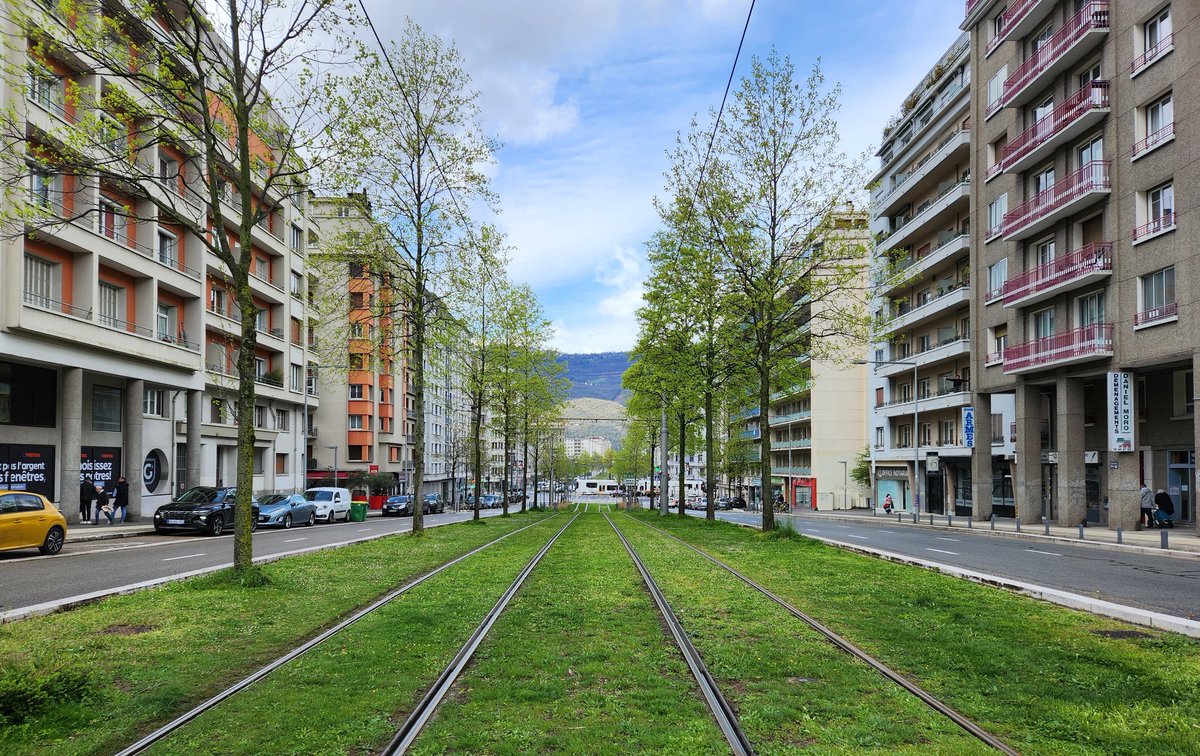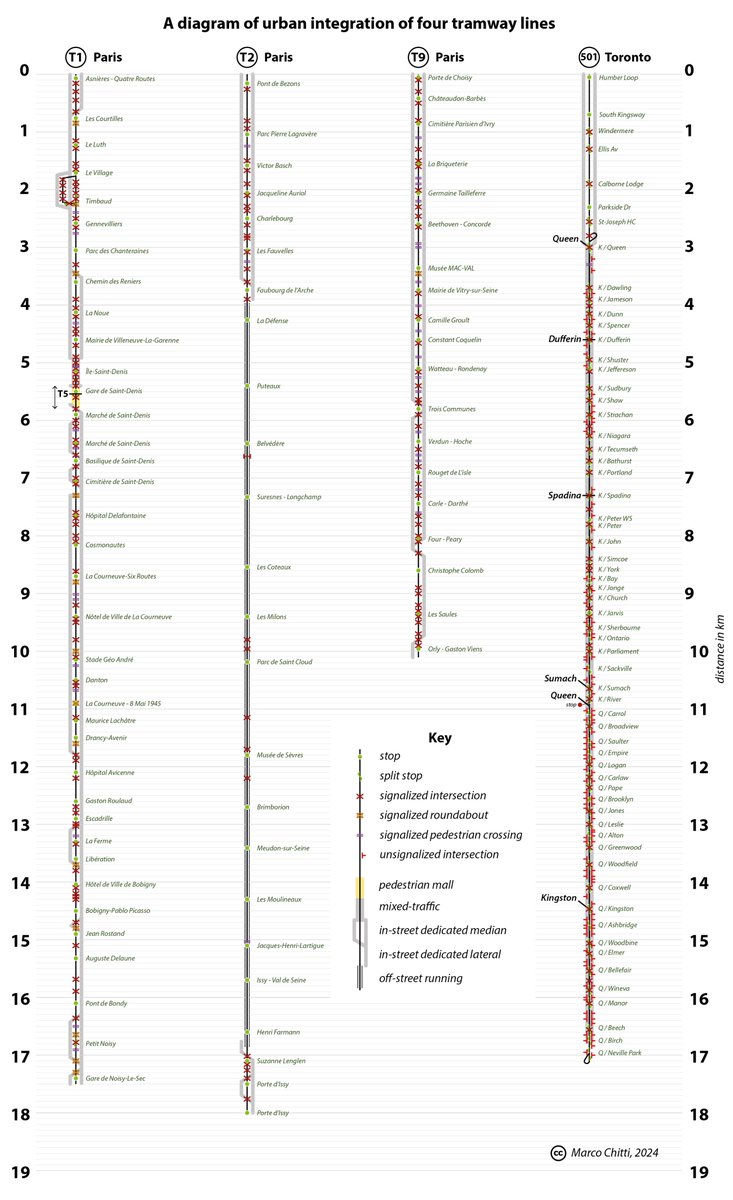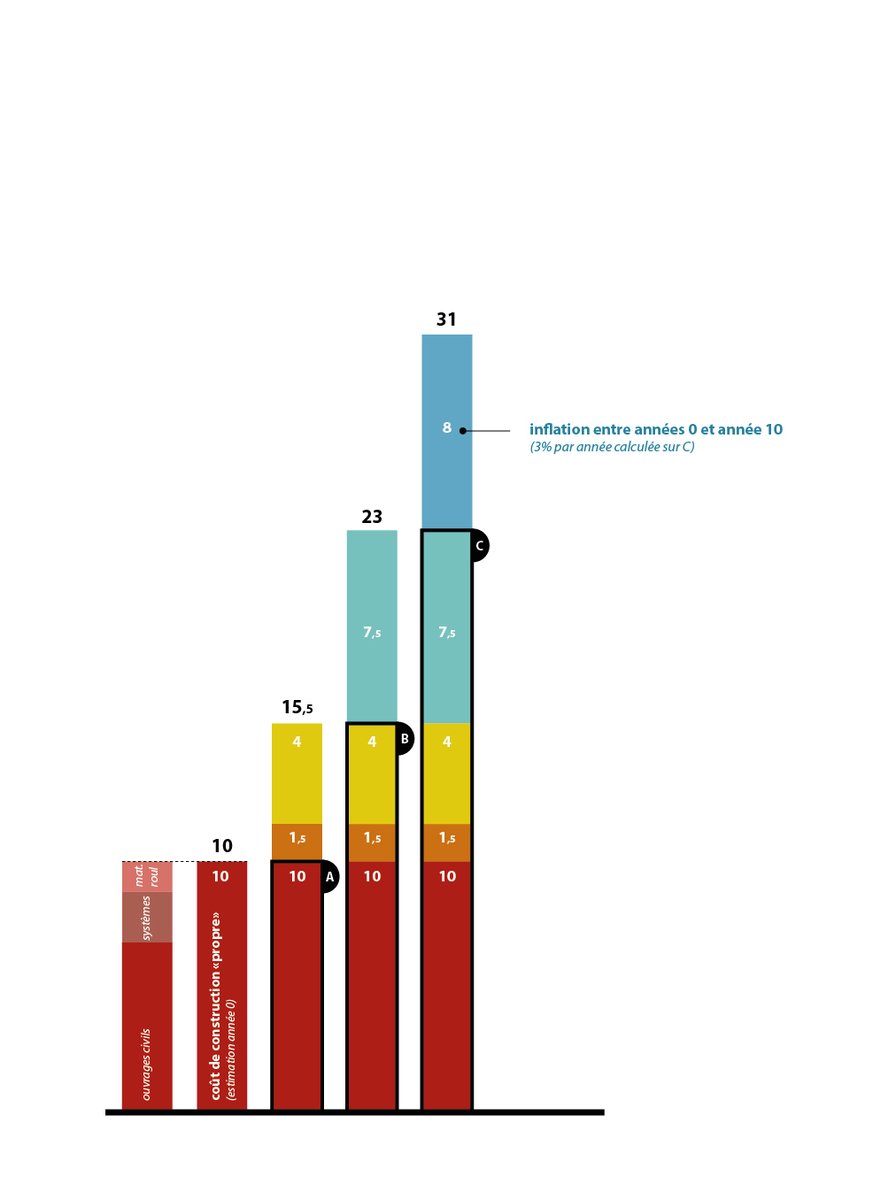
Architect, Urban Planner, PhD
** I make a lot of typos (and my English is far from perfect). Please be patient**
5 subscribers
How to get URL link on X (Twitter) App


 The only greenfield section part of the overall pre-metro scheme built in the initial phases run either underground or in a freeway median, within an area of interwar (Romerstadt) and postwar modernist development.
The only greenfield section part of the overall pre-metro scheme built in the initial phases run either underground or in a freeway median, within an area of interwar (Romerstadt) and postwar modernist development.




 The historical reason is that France, outside of Paris intramuros, it's not a country of Grand Boulevards and large urban schemes. With one of the most property owners-friendly land regimes, French cities mostly grew with chaotic street patterns during both the 19th and 20th c.
The historical reason is that France, outside of Paris intramuros, it's not a country of Grand Boulevards and large urban schemes. With one of the most property owners-friendly land regimes, French cities mostly grew with chaotic street patterns during both the 19th and 20th c.

https://twitter.com/ChittiMarco/status/1816140463264694518


 First, the Seattle approach (veru common in NA mined stations) is to go with a large cavern encompassing both tracks, a central platform and a "full-length mezzanine, that is a slab above the platform level allowing for horizontal circulation outside of platform space
First, the Seattle approach (veru common in NA mined stations) is to go with a large cavern encompassing both tracks, a central platform and a "full-length mezzanine, that is a slab above the platform level allowing for horizontal circulation outside of platform space 




 Naples' line 6 has a very troubled history. It was initially planned in the early 1980s as the "Linea Tranviaria Rapida", an LRT-like system mixing at-grade and grade-separated segments crossing the city East-West roughly along the coast.
Naples' line 6 has a very troubled history. It was initially planned in the early 1980s as the "Linea Tranviaria Rapida", an LRT-like system mixing at-grade and grade-separated segments crossing the city East-West roughly along the coast. 

 The 19th c. railways had very low platforms, just slightly higher than the tracks, either in wood, masonry, or simply a stone curb filled with gravel. Essentially, a glorified sidewalk.
The 19th c. railways had very low platforms, just slightly higher than the tracks, either in wood, masonry, or simply a stone curb filled with gravel. Essentially, a glorified sidewalk. 


 Tramway line 3 covers the 4.3 km, 11-stop section between its terminus at Albisrieden to Sihlpost /HB in 16 minutes, with consistent running times throughout the say, averaging a pretty good 16 km/h speed.
Tramway line 3 covers the 4.3 km, 11-stop section between its terminus at Albisrieden to Sihlpost /HB in 16 minutes, with consistent running times throughout the say, averaging a pretty good 16 km/h speed.

 Starting from west and going east, inbound toward the city center, the tram line gets out of its lateral dedicated alignment to merge into mixed traffic after the Gimmelfinger Weg stop
Starting from west and going east, inbound toward the city center, the tram line gets out of its lateral dedicated alignment to merge into mixed traffic after the Gimmelfinger Weg stop 


 The Grand Boulevards were intended to become the major East-West thoroughfare, the urban continuation of the "penetrante urbaine", i.e. the motorway branch feeding into the urban core, a typical element of both French and Italian 1960s traffic and urban planning.
The Grand Boulevards were intended to become the major East-West thoroughfare, the urban continuation of the "penetrante urbaine", i.e. the motorway branch feeding into the urban core, a typical element of both French and Italian 1960s traffic and urban planning. 


 For the same reason, the far-side split stop, very common in the US & Canada, is quite rare among modern French tramways, because of the tram-only phase and that fact that there is no need for a near-side left-turn lane in the buffer occupied by the stop far-side
For the same reason, the far-side split stop, very common in the US & Canada, is quite rare among modern French tramways, because of the tram-only phase and that fact that there is no need for a near-side left-turn lane in the buffer occupied by the stop far-side 

 The diagram, which is a work in progress, highlights the position of a few key elements that define the performance of tramway vehicles such as stops, signalized/unsignalized intersections and the type of right of way
The diagram, which is a work in progress, highlights the position of a few key elements that define the performance of tramway vehicles such as stops, signalized/unsignalized intersections and the type of right of way 


 Par "trillium-fication' j'entends la bonification du service de train de banlieue SJ afin de permettre un service fréquent cadencé (p.ex. 15 minutes dans le tronc commun, 30 dans les antennes), 7 jours/semaine et avec une amplitude horaire similaire à celle du métro et du REM.
Par "trillium-fication' j'entends la bonification du service de train de banlieue SJ afin de permettre un service fréquent cadencé (p.ex. 15 minutes dans le tronc commun, 30 dans les antennes), 7 jours/semaine et avec une amplitude horaire similaire à celle du métro et du REM.


 The hypothesis (limited to rue Sherbrooke) is of an LRT similar to the recently opened Edmonton's LRT: stop spacing of 1.2 km on average (2.5-3 times the typical Euro tram) and an average speed of 26 km/h
The hypothesis (limited to rue Sherbrooke) is of an LRT similar to the recently opened Edmonton's LRT: stop spacing of 1.2 km on average (2.5-3 times the typical Euro tram) and an average speed of 26 km/h

 The reason it seldom exists is that passing from totally grade-separated RoW (A) to either dedicated on-street (B) or mixed-traffic (C) means getting rid of an entire category of technological solutions for the vehicle, the driving, the signaling, the platform height etc.
The reason it seldom exists is that passing from totally grade-separated RoW (A) to either dedicated on-street (B) or mixed-traffic (C) means getting rid of an entire category of technological solutions for the vehicle, the driving, the signaling, the platform height etc.




 It was planned in the late 1980s by the FCL (Ferrovie Calabro-Lucane) as a meter gauge diesel line to serve the stadium built for the 1990 world cup and the grandiose scheme for urban development toward the south of the city of Bari that never fully materialized
It was planned in the late 1980s by the FCL (Ferrovie Calabro-Lucane) as a meter gauge diesel line to serve the stadium built for the 1990 world cup and the grandiose scheme for urban development toward the south of the city of Bari that never fully materialized 

 Long-distance bus service was never publicly-run in Italy, as the national policy favored railway for long-distance trips, but until 2014 it was regulated under a "concession" regime, where private operators were granted the right to run a particular route.
Long-distance bus service was never publicly-run in Italy, as the national policy favored railway for long-distance trips, but until 2014 it was regulated under a "concession" regime, where private operators were granted the right to run a particular route.




 These images once again bring home the fact that modern railways are just a road with ballast, tracks and catenary on top,what RFI calls "sovrastruttura ferroviaria", that is normally even contracted out separately
These images once again bring home the fact that modern railways are just a road with ballast, tracks and catenary on top,what RFI calls "sovrastruttura ferroviaria", that is normally even contracted out separately




https://twitter.com/GregoryRambour/status/1733437080020332713
 T12 is made of two different parts in terms of alignement (thus average speed): The tram-train part running on the mainline rail alignement formerly used by a RER C branch (39kph) and a new "fast tram" type of alignement, with a mix of off-street and in-street sections (24kph)
T12 is made of two different parts in terms of alignement (thus average speed): The tram-train part running on the mainline rail alignement formerly used by a RER C branch (39kph) and a new "fast tram" type of alignement, with a mix of off-street and in-street sections (24kph) 



 Comme toute activité économique, la production de ce service publique doit être en équilibre entre recettes et dépenses, c-à-d les coûts de production du service: il faut payer les salaires des chauffeurs, les pièces de rechange des bus, le carburant, l'entretien des garages, etc
Comme toute activité économique, la production de ce service publique doit être en équilibre entre recettes et dépenses, c-à-d les coûts de production du service: il faut payer les salaires des chauffeurs, les pièces de rechange des bus, le carburant, l'entretien des garages, etc 


 Prémisse: le modèle de partenariat public-privé promu par CDPQ avec le REM est un unicum mondial parmi les modèles dites DBFOM(Design-Build-Finance-Operate-Maintain) pour un grand nombre de raisons, mais en particulier pour la distribution des risques et le payment des redevances
Prémisse: le modèle de partenariat public-privé promu par CDPQ avec le REM est un unicum mondial parmi les modèles dites DBFOM(Design-Build-Finance-Operate-Maintain) pour un grand nombre de raisons, mais en particulier pour la distribution des risques et le payment des redevances




 D'abord, rappelez-vous qu'il s'agit de projet qui sont encore sur la table à dessin, donc il s'agit d'estimations
D'abord, rappelez-vous qu'il s'agit de projet qui sont encore sur la table à dessin, donc il s'agit d'estimations
 As the section was judged too short to deploy a TBM effectively and to reduce the depth of the tunnel (and thus of the stations) while avoiding to move all the utilities they opted for a traditional mining technique with consolidation from above (jet grouting injection)
As the section was judged too short to deploy a TBM effectively and to reduce the depth of the tunnel (and thus of the stations) while avoiding to move all the utilities they opted for a traditional mining technique with consolidation from above (jet grouting injection) 